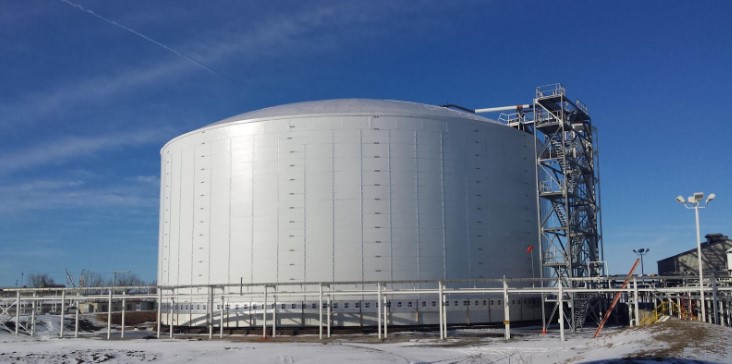
How Is Tank Insulation Installed in Oil Fields?
How Is Tank Insulation Installed in Oil Fields?
In the oil and gas sector, the preservation of energy, control of process temperatures, and protection against frost heave are critical for operational efficiency and safety. One crucial component that aids in these aspects is tank insulation. This blog post will guide you through the steps and considerations involved in the installation of tank insulation, specifically within the challenging environments of oil fields.
Introduction to Tank Insulation
Tank insulation in oil fields is essential for several reasons. It helps maintain the temperature of the stored substances, reduces energy costs, and prevents the contents from freezing or overheating, which could lead to operational failures and hazards. G & R Insulating Ltd., based in Clairmont, AB, specializes in this critical service, ensuring that energy companies can achieve optimal performance and safety standards.
Understanding The Importance of Tank Insulation
Before diving into the installation process, it’s important to understand why tank insulation is pivotal in oil fields. Insulation reduces the transfer of heat between the contents of a tank and its external environment. This is particularly important in regions like western Canada where temperature fluctuations are common. Proper insulation helps in maintaining the integrity and viscosity of the oil, which can be crucial for pumping and processing.
Types of Tank Insulation Materials
Selecting the right materials is the first step in the tank insulation process. Materials commonly used for insulating tanks in oil fields include mineral wool, fiberglass, foam glass, and cellular glass. These materials are chosen based on their thermal resistance properties, durability, and compatibility with the stored substance and environmental conditions.
Preparing for Installation
Proper preparation is key to successful tank insulation. This includes cleaning the tank’s surface, removing any rust, and ensuring that the surface is dry. Preparing the surface helps in achieving a good bond between the insulation material and the tank surface, which is critical for the longevity and effectiveness of the insulation.
Installing The Insulation Base Layer
The base layer of insulation is crucial as it forms the primary barrier against thermal transfer. This layer is typically installed using bands and seals to hold it in place. Ensuring that this layer is evenly applied and securely fastened is essential for its effectiveness and durability.
Applying The Weatherproof Outer Layer
Once the base layer is securely installed, a weatherproof outer layer is applied. This layer protects the insulation from environmental factors such as moisture, wind, and UV radiation. Materials often used for the outer layer include aluminum, stainless steel, or weather-resistant fabrics, depending on the specific needs and budget constraints.
Considerations For High-Temperature Tanks
When dealing with tanks that store high-temperature substances, additional considerations are necessary. High-temperature tank insulation often requires materials that can withstand extreme heat without degrading. It might also include a ventilation system to manage heat effectively and prevent overheating of the surrounding environment.
Maintenance and Inspection of Tank Insulation
Regular maintenance and inspection are crucial to ensure the longevity and effectiveness of tank insulation. This includes checking for any signs of wear and tear, moisture ingress, and degradation of materials. Maintenance routines should be established according to the manufacturer’s recommendations and environmental conditions.
The Role of Custom Insulation Covers
In some cases, custom insulation covers are used for tank insulation. These are particularly useful for tanks with irregular shapes or those that require frequent access for inspection and maintenance. Custom covers can be designed to fit perfectly and offer the flexibility of easy removal and reinstallation.
Advanced Techniques in Tank Insulation
Advancements in technology have led to the development of new insulation techniques, such as spray foam insulation and pre-insulated panels. These techniques offer benefits in terms of installation speed, effectiveness, and environmental resistance. They are becoming increasingly popular choices in modern tank insulation projects.
Concluding Thoughts on Tank Insulation in Oil Fields
The installation of tank insulation is a complex process that requires careful planning, execution, and maintenance. For companies like G & R Insulating Ltd., understanding the specific needs of each project in the oil and gas sector is crucial. With the right approach and materials, tank insulation can significantly enhance operational efficiency, safety, and environmental compliance in oil fields.
Frequently Asked Questions (FAQ)
Q: What is tank insulation, and why is it important in oil fields?
A: Tank insulation involves applying insulative materials to storage tanks to control the temperature of their contents. This is crucial in oil fields to maintain the chemical stability of the oil, prevent freezing, reduce energy costs, and protect the surrounding environment by controlling the heat emissions from the tanks.
Q: What types of insulation materials are used in oil fields?
A: The most common insulation materials used in oil fields include mineral wool, fiberglass, foam glass, and cellular glass. These materials are selected based on their thermal resistance, moisture resistance, and durability under harsh environmental conditions.
Q: How is tank insulation installed?
A: Tank insulation is typically installed in layers. First, a base layer of insulative material is applied directly to the cleaned and prepared surface of the tank. This is followed by securing it with bands and seals. A protective weatherproof outer layer is then added to shield the insulation from environmental factors like moisture and UV radiation.
Q: Are there different insulation methods for different types of tanks?
A: Yes, the insulation method can vary depending on the type of tank and its contents. High-temperature tanks may require specialized insulation materials that can withstand extreme heat, whereas tanks containing volatile chemicals might need insulation with better fire-resistant properties.
Q: How often should tank insulation be inspected?
A: Tank insulation should be inspected at least annually to ensure it remains effective. Inspections should check for signs of wear and tear, moisture ingress, and other damage. More frequent inspections may be necessary in harsh environments or if the tanks contain particularly sensitive or hazardous substances.
Conclusion
In conclusion, the installation of tank insulation in oil fields is a vital aspect of ensuring operational efficiency, safety, and environmental responsibility. Companies like G & R Insulating Ltd. play a crucial role in providing expert services tailored to the unique needs of the oil and gas sector in western Canada. By employing the right materials, techniques, and maintenance practices, tank insulation not only preserves energy and protects against temperature fluctuations but also contributes to the long-term sustainability of oil field operations. With a commitment to excellence in insulation solutions, companies can navigate the challenges of the industry while maximizing performance and minimizing risks.




